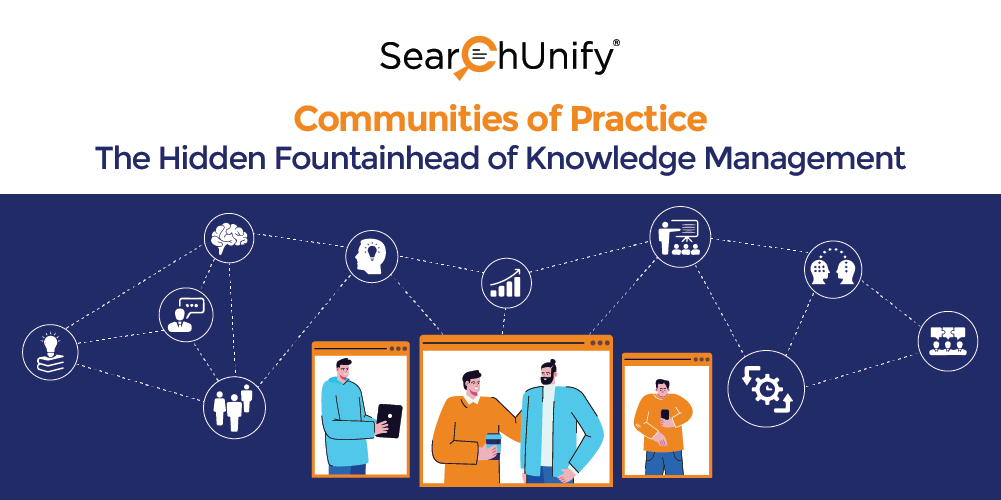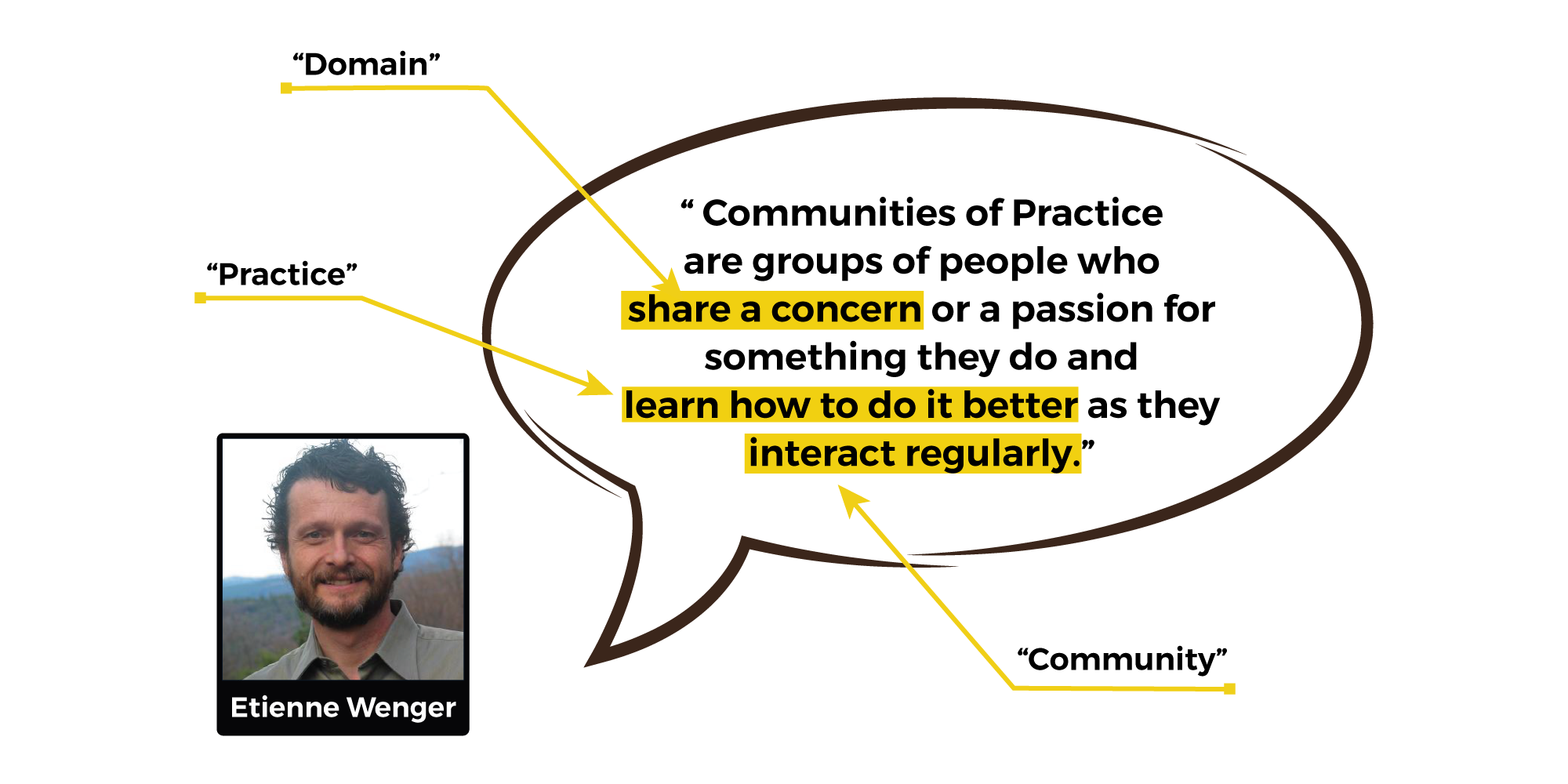
Knowledge Management is progressing at an unprecedented rate. Low-code development platforms and AI are fueling a revolution that is taking the customer service industry by storm.
In light of this, most enterprises have veered to meet short-term survival goals. But long-term success requires more potent organizational forms like Community of Practice (CoPs).
This agile framework not only promises to enrich the existing processes but also steer the organization clear of knowledge management whirlpools.
Sounds great, right? Time to unravel what it brings to the table. Let’s dig in.
First Things First—What are Communities of Practice?
“Communities of practice are groups of people who share a concern or a passion for something they do and learn how to do it better as they interact regularly.” – Etienne Wenger
While communities of practice in knowledge management come across as a recent coinage, the idea behind it is ancient. Cognitive anthropologists Jean Lave and Etienne Wenger coined the term in 1991. But it is only recently that firms have started realizing the value of adopting CoP as a framework for employee knowledge sharing.
After reading its definition, some people felt that this is what an ordinary circle of work buddies or community group does. Well, not entirely.
Wenger introduced the three pillars of CoP that differentiate it from the vanilla workgroups.
- DOMAIN: Members of the community are categorized in the shared domain of interest, such as Marketers, Engineers, Product Experts, HRs, Project Managers, etc. They accordingly identify and solve the hurdles faced by their peers.
- COMMUNITY: As a next step, different domain members come together to interact and learn from each other’s knowledge and experiences. This fosters collective learning.
- PRACTICE: Here, community members develop a repertoire of resources—experiences, stories, tools, ways of addressing recurring problems—as a shared practice.

The Burning Question—Why Prioritizing CoPs is the Need of Hour?
Remember when the pandemic shook businesses around the world to their core? Scrambled to take cover, most enterprises jumped on the digital transformation bandwagon without realizing that a slew of hurdles—disrupted communication, limited collaboration, underdeveloped technology, etc.—were waiting ahead.
For instance, various lockdown restrictions during the crisis pushed educational institutions to reinvent their operations to facilitate e-learning. It also questioned the readiness of stakeholders—students, parents, educators, management—for the new systems. And the communication woes only added more layers of complexity.
Several institutions were stuck in the trenches trying to make sense of how to respond to the situation. This is where forward-thinking academia prevailed. They quickly formed virtual communities of practice to support one another in challenging times. Similarly, other sectors leveraged CoPs to help employees and partners circumvent all the challenges.
Let’s get down to brass tacks and see how it benefits the organizations across industries:
Why focus on communities of practice? |
||
| for members | for organizations | |
| short-term value |
|
|
| long-term value |
|
|
| From: Wenger’s Cultivating Communities of Practice: a quick start-up guide | ||
Companies like HP, World Bank, American Management System have also adopted the framework and are leaping giant strides towards success.
But How Is It Different from Other Groups or Teams?
Think of it this way: a team is formed to complete a project within a specified timeframe. However, CoPs help connect and learn with various domain experts in an informal environment.
Here’s a table that breaks out the details between CoPs and other groups.
COMPARISON |
|||||
| MEMBERS | COMMUNITY | LEADERSHIP | DURATION | EFFECTIVENESS | |
| COMMUNITY OF PRACTICE | Practitioners who share passion for learning and improving an organization’s welfare | Members don’t necessarily work together regularly. Build network through shared interests. | Elected Leader | As long as the members of communities desires | High |
| PROFESSIONAL TEAMS | Formal group of professionals created by managers to deliver product or service | Members are put in the team for the soul purpose of working together | Senior Management | Depends on the organization’s requirement | Depends |
| PROJECT TEAMS | Experts responsible to produce deliverables in the project plan within specified timeframe | Members are put in the team for the soul purpose of working together | Project Manager | Until the project is completed | Depends |
| INFORMAL WORK GROUPS | Group of people formed on the basis of common likes, dislikes, prejudices, contacts, language | Members work together in an organization | No Leader | As long as the members desires | Depends |
| COMMUNITY OF INTEREST | Group of people with a common set of concerns including ethnicity, racisim, etc. that may be affected by legislation | Members don’t necessarily work together regularly. Build network through shared interests. | Elected Leader | Until the topic is covered | Depends |
| PROFESSIONAL LEARNING COMMUNITIES | Educators willing to improve student’s learning experience | Members work together in educational institutions | Principal or Top Management | Until the goal is met | High |
Hope it clarifies the difference. But another question pops up: how do we cultivate a community of practice? Fret not; we’ve got you covered. Let’s understand how.
Best Practices to Nurture Community of Practice
Below are a few ways to keep your members engaged and provide enduring professional enrichment.
1. Keep on Bringing New & Diverse Perspectives
CoPs consist of experienced professionals from different domains. There might come a time when they don’t see a point showing up if similar topics are discussed repeatedly. To prevent that, subjects on industry trends, case studies, success stories, etc., must become part of discussions that will bring new perspectives and keep the members engaged.
2. Continue to Reflect, Refine, & Grow
The main goal of the CoPs is to share and learn. But if members don’t find value, they are unlikely to participate and may drop out soon. In addition to aiming for relevant topics, try finding ways to garner their feedback on improving the community. Incorporate the ideas and continue to replicate and refine those aspects.
3. Adopt Collaboration Tools If Necessary
In the digital era, it is imperative to use virtual collaboration tools and online forums to exchange educational resources. They give you greater control over learning and accessibility. In addition, they also promote a healthy communication environment as the members can share ideas and ask questions at any time, anywhere.
The Road Ahead
Getting knowledge management right is what many companies grapple with. That’s why integrating and cultivating agility with ‘Communities of Practice’ is the way to organizational success.

















